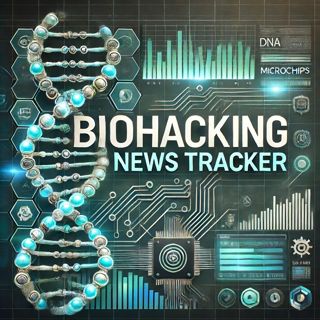
The Booming Biohacking Market: Personalized Healthcare and Transformative Solutions
The biohacking industry is experiencing rapid growth, driven by increasing consumer interest in personalized healthcare solutions and advancements in biotechnology. Recent market research indicates that the global biohacking market is expected to reach USD 83 billion by 2032, growing at a compound annual growth rate (CAGR) of 18.4% from 2024 to 2032[5].Key factors contributing to this growth include the rising demand for wearable devices, nootropic drugs, and innovative technologies like neurofeedback and CRISPR. Wearable devices, particularly wearable medical devices, accounted for the largest revenue share at over 34% in 2023[5]. The monitoring segment dominated the market, holding more than 32% of revenue, with treatment expected to grow at the fastest CAGR[5].North America led the market with a 39% revenue share, followed by Asia Pacific. The APAC biohacking market is expected to witness rapid development in the near term, driven by the revamping healthcare sector and growing investment[2].Emerging trends such as microbiome engineering, synthetic biology, and the integration of Eastern and Western medicine are further expanding possibilities in the biohacking industry. The rise of DIY biology and biohacking spaces fosters global collaboration and innovation, while regulatory bodies emphasize safety and oversight[5].Recent market movements include the increasing adoption of biohacking products and services, as well as the rising global health consciousness among consumers. The demand for advanced wearable devices is expected to propel the growth of the biohacking market, with wearable devices aiding biohacking by providing real-time data on bodily functions[4].In terms of consumer behavior, there is a growing interest in personalized healthcare solutions, with individuals striving to enhance their health and performance through innovative techniques. The biohacking market is poised to redefine healthcare, offering transformative solutions to enhance health, performance, and longevity[5].Industry leaders are responding to current challenges by investing in research and development, as well as partnering with other companies to expand their product offerings. For example, technology company Blackbook.ai has developed a virtual assistant to help health professionals tackle an enormous amount of contact tracing[2].Compared to previous reporting, the biohacking market has seen significant growth, with the global market size valued at USD 19 billion in 2023, up from USD 20.17 billion in 2023[2][5]. The market is expected to continue growing, driven by advancements in biotechnology and increasing consumer interest in personalized healthcare.In conclusion, the biohacking industry is experiencing rapid growth, driven by increasing consumer interest in personalized healthcare solutions and advancements in biotechnology. Emerging trends and technologies are further expanding possibilities, and industry leaders are responding to current challenges by investing in research and development and partnering with other companies. The biohacking market is poised to redefine healthcare, offering transformative solutions to enhance health, performance, and longevity.This content was created in partnership and with the help of Artificial Intelligence AI
28 Jan 3min

Biohacking Boom: Revolutionizing Personal Health with Tech and Personalization
The biohacking industry is experiencing rapid growth, driven by increasing consumer demand for personalized health solutions and advancements in technology. According to recent market research, the global biohacking market is expected to grow at a compound annual growth rate (CAGR) of 18.50% between 2025 and 2032, reaching an estimated value of over USD 113.03 billion by the end of the forecast period[1].Key segments in the biohacking market include DIY biology, nutrigenomics, wearable health devices, genetic testing, and neuro-enhancement products. Wearable devices, particularly fitness trackers and smartwatches, dominate the market due to their widespread adoption for health monitoring, fitness tracking, and personalized insights[3].North America currently leads the biohacking market, backed by the strategic presence of key players in developed countries such as the U.S. and Canada. However, the Asia Pacific region is expected to be the fastest-growing market, driven by increasing health consciousness and technological advancements[2].Recent market movements include a growing awareness of the potential benefits of biohacking, alongside a rising consumer demand for personalized health solutions. The market is also fueled by advancements in genetics, artificial intelligence (AI), and the Internet of Things (IoT), which continue to reshape healthcare[1].Emerging competitors in the biohacking market include companies such as Thync Global Inc., Synbiota, Apple, HVMN, Inc., MoodMetric, and The ODIN. These companies are responding to current challenges by developing innovative products and services, such as wearable devices, nootropics, and gene-editing tools[4][5].Regulatory changes are also impacting the biohacking market, with strict regulations governing genetic engineering experiments and a lack of funds required for research. However, the market is expected to continue growing, driven by increasing consumer demand and technological advancements[4].In terms of consumer behavior, there is a growing trend towards health-conscious consumers seeking personalized health solutions. This shift is driving the adoption of biohacking products and services, particularly wearable devices and nootropics[3][5].Price changes and supply chain developments are also impacting the biohacking market. The increasing demand for biohacking products and services is driving up prices, while supply chain disruptions are affecting the availability of certain products[5].Overall, the biohacking industry is experiencing rapid growth, driven by increasing consumer demand and technological advancements. Industry leaders are responding to current challenges by developing innovative products and services, while regulatory changes and supply chain developments are also impacting the market.Recent statistics and data from the past week include:- The global biohacking market is expected to grow at a CAGR of 18.50% between 2025 and 2032, reaching an estimated value of over USD 113.03 billion by the end of the forecast period[1].- The biohacking market accounted for USD 25.3 billion in 2024 and is expected to reach USD 168.3 billion by 2035, growing at a CAGR of around 18.8% between 2025 and 2035[3].- North America currently leads the biohacking market, backed by the strategic presence of key players in developed countries such as the U.S. and Canada[2].- The Asia Pacific region is expected to be the fastest-growing market, driven by increasing health consciousness and technological advancements[2].- Wearable devices, particularly fitness trackers and smartwatches, dominate the market due to their widespread adoption for health monitoring, fitness tracking, and personalized insights[3].This content was created in partnership and with the help of Artificial Intelligence AI
27 Jan 4min

The Biohacking Boom: Transforming Personal Health and Wellness in the Digital Age
The biohacking industry is experiencing rapid growth, driven by increasing consumer awareness and demand for personalized health solutions. Recent market research indicates that the global biohacking market is expected to grow at a compound annual growth rate (CAGR) of 18.50% between 2025 and 2032, reaching an estimated value of over USD 113.03 billion by the end of the forecast period[1].Key segments in the biohacking market include DIY biology, nutrigenomics, wearable health devices, genetic testing, and neuro-enhancement products. Advancements in genetics, artificial intelligence (AI), and the Internet of Things (IoT) are reshaping healthcare and integrating biohacking into mainstream wellness practices[1][2].North America currently dominates the biohacking market, backed by the strategic presence of key players in developed countries such as the U.S. and Canada. However, the Asia Pacific region is expected to witness rapid development due to the revamping healthcare sector and growing investment in biohacking technologies[2][4].Recent trends in the biohacking market include the growing use of wearable devices for personal health monitoring and patient care delivery. Companies are exploring the benefits of supplying wearable health technology to their consumers, leading to a booming market for smart devices[2][3].Key industry leaders are responding to current challenges by focusing on customized mental health optimization services, combining biofeedback, nootropics, and personalized treatments. Platforms that allow individuals to track key biomarkers are also gaining traction, helping to prevent diseases and optimize health[3].Comparing current conditions to previous reporting, the market size has shown significant growth. The biohacking market was valued at USD 20.17 billion in 2023 and is expected to reach USD 95.80 billion by 2032, according to some reports[2]. However, other sources project a higher growth rate, with the market reaching USD 168.3 billion by 2035[3].In terms of consumer behavior, there is a growing demand for smart devices and effective drugs, coupled with an increasing consciousness of biohacking. This is accelerating regional market growth, particularly in the Asia Pacific region[2][4].Supply chain developments include the integration of IoT in healthcare, fitness, and consumer electronics, which is driving the growth of the biohacking industry. Additionally, advancements in 3D printing for custom implants and smart implants with IoT integration are gaining traction[5].Overall, the biohacking industry is poised for significant growth, driven by technological advancements, increasing consumer demand, and the integration of biohacking into mainstream wellness practices. Industry leaders are responding to current challenges by focusing on customized health solutions and leveraging advancements in wearable devices and supplements.This content was created in partnership and with the help of Artificial Intelligence AI
24 Jan 3min

The Booming Biohacking Industry Transforming Personalized Healthcare
The biohacking industry has experienced significant growth and transformation in recent years, driven by increasing consumer interest in personalized healthcare, advancements in wearable technology, and a rising awareness of preventative health measures. As of 2024, the global biohacking market was valued at approximately USD 24.06 billion, with projections indicating it will reach USD 133.19 billion by 2034, growing at a compound annual growth rate (CAGR) of 18.7%[1].Key factors contributing to this growth include the integration of artificial intelligence (AI) and machine learning in biohacking tools, the expansion of nootropics and nutraceuticals, and the rise of DIY biology practices. Wearable devices, such as fitness trackers, smartwatches, and continuous glucose monitors, have become increasingly popular among consumers seeking real-time health insights[1][3].Recent market movements highlight the dynamic landscape of the biohacking industry. For instance, the market is expected to grow from USD 36.61 billion in 2024 to USD 45.16 billion in 2025, at a CAGR of 23.4%[5]. This growth is attributed to increased health awareness, access to information, entrepreneurial culture, and the quantified self-movement.Emerging competitors and new product launches are also driving the market forward. Companies like Velovita have introduced dietary supplements like Zlem, aimed at improving sleep quality and weight management[5]. Additionally, SickScience Labs, Inc. has launched the Biohacking Body-Sculpting Serum, featuring Biotech-Powered Nx35 technology to improve skin firmness and texture[5].Regulatory changes and significant market disruptions are also influencing the biohacking industry. The rising prevalence of chronic diseases is expected to propel market growth, with biohacking methods such as improving nutrition, intermittent fasting, and hydrogen inhalation therapy gaining popularity[5].Consumer behavior is shifting towards a greater emphasis on personalized health solutions, with the adoption of biohacking practices like meditation and intermittent fasting increasing. The meditation market in the US is predicted to reach USD 2.08 billion by 2022, indicating a growing demand for biohacking practices[5].Industry leaders are responding to current challenges by focusing on advanced solutions, such as research-grade technology, to enhance innovation and precision in biotechnology applications. Companies like SickScience Labs, Inc. are leveraging high-quality equipment and tools to develop regenerative therapies[5].Comparing current conditions to previous reporting, the biohacking market has seen consistent growth and expansion. The market size has grown exponentially in recent years, driven by increased health awareness and the adoption of biohacking practices. The integration of AI, machine learning, and wearable technology continues to shape the industry, with emerging competitors and new product launches contributing to its dynamic landscape.In conclusion, the biohacking industry is experiencing rapid growth and transformation, driven by consumer demand for personalized health solutions, advancements in technology, and a rising awareness of preventative health measures. As the industry continues to evolve, it is expected to reach USD 133.19 billion by 2034, with a CAGR of 18.7%. Industry leaders are responding to current challenges by focusing on advanced solutions and leveraging high-quality equipment and tools to develop innovative biotechnology applications.This content was created in partnership and with the help of Artificial Intelligence AI
23 Jan 4min

The Biohacking Revolution Reshaping Personal Health and Performance
The biohacking industry is experiencing rapid growth, driven by increasing consumer demand for personalized health solutions and advancements in technology. According to recent market research, the global biohacking market is expected to grow at a compound annual growth rate (CAGR) of 18.50% between 2025 and 2032, reaching an estimated value of over USD 113.03 billion by the end of the forecast period[1].Key drivers of this growth include the rising prevalence of chronic diseases, which biohacking methods such as improving nutrition, intermittent fasting, and hydrogen inhalation therapy can help combat[4]. Additionally, the demand for advanced wearable devices is propelling the growth of the biohacking market, with wearable devices providing real-time data on bodily functions and enabling users to optimize health and performance through personalized insights and interventions[4].Recent market movements indicate a strong focus on wearable devices, with the wearable segment dominating the market and accounting for 19% of revenue in the year[2]. Companies such as Apple and Fitbit are leading the way in this segment, with Apple's smartwatch shipments increasing by 17% in 2022 and accounting for about 60% of the global smartwatch market revenue[4].Emerging competitors in the biohacking market include companies such as Thync Global Inc, Synbiota, and HVMN, Inc, which are developing innovative products and services such as nootropics, gene-editing tools, and smart implants with IoT integration[5].New product launches in the biohacking market include advanced wearable devices, genetic testing kits, and neuro-enhancement products. For example, the Oura ring, a wearable device that tracks sleep patterns, heart rate, and other health metrics, has gained popularity among consumers[2].Regulatory changes are also shaping the biohacking market, with advancements in genetic editing and CRISPR technology driving growth in the gene modification segment[4]. However, these advancements also bring forth ethical challenges that need to be addressed thoughtfully.In terms of consumer behavior, there is a growing trend towards health-consciousness, with consumers seeking personalized health solutions and adopting biohacking methods to optimize their health and performance. This shift in consumer behavior is driving the growth of the biohacking market, with companies responding by developing innovative products and services that cater to this demand.Compared to previous reporting, the current conditions in the biohacking market indicate a significant increase in growth rate, with the market expected to reach USD 113.03 billion by 2032, up from USD 29.07 billion in 2024[1]. This growth is driven by the increasing adoption of biohacking products and services, as well as the rising global health consciousness among consumers.Overall, the biohacking industry is experiencing rapid growth, driven by increasing consumer demand for personalized health solutions and advancements in technology. Companies are responding to this demand by developing innovative products and services, and the market is expected to continue growing at a significant rate in the coming years.This content was created in partnership and with the help of Artificial Intelligence AI
22 Jan 3min

Biohacking's Surge: Transforming Personal Health with Tech, AI, and Evolving Consumer Trends
The biohacking industry is experiencing significant growth, driven by increasing consumer interest in personalized healthcare and advancements in wearable technology. Recent market research indicates that the global biohacking market size was valued at approximately USD 24.06 billion in 2024 and is projected to grow to USD 133.19 billion by 2034, exhibiting a compound annual growth rate (CAGR) of 18.7% during 2025-2034[1].Key factors fueling this growth include the integration of artificial intelligence (AI) and machine learning in biohacking tools, the expansion of nootropics and nutraceuticals, and the rise of DIY biology practices. The market is also supported by a demand for data-driven solutions to optimize physical and cognitive well-being.North America dominates the biohacking market, backed by advanced healthcare infrastructure, high consumer awareness, and significant investments in biotechnology and wearable technologies. The region's leadership is further supported by a strong presence of key market players and a well-established ecosystem for research and development in personalized medicine and genetic engineering[1][2].Emerging competitors are leveraging advancements in genetics, AI, and the Internet of Things (IoT) to reshape healthcare and integrate biohacking into mainstream wellness practices. New product launches include wearable devices designed to monitor and optimize physical and cognitive health, such as fitness trackers, smartwatches, and continuous glucose monitors[1][3].Regulatory changes are also influencing the market. The biohacking domain is notably restrained by strict regulatory issues, especially those associated with health claims and genetic modifications. However, the market is opportune to factors like growing demand for personalized health solutions, growing alliances with healthcare providers, and progressing nutraceuticals and supplements markets[4].Consumer behavior is shifting towards a greater emphasis on preventive health and personalized medicine. The increasing adoption of wearable devices and the rising prevalence of chronic diseases are contributing to the region's dominance in the global market. Biohacking industry leaders are responding to current challenges by integrating advanced technologies, such as AI and synthetic biology, to meet evolving consumer needs. They are also leveraging direct-to-consumer approaches, social media, and influencer marketing to educate and engage health-conscious users[1][4].Comparing current conditions to the previous reporting period, the biohacking market has seen significant growth. The market size has increased from USD 20.17 billion in 2023 to USD 24.06 billion in 2024, and the CAGR has remained steady at around 18.7%[1][2].In conclusion, the biohacking industry is experiencing rapid growth, driven by advancements in technology and increasing consumer demand for personalized health solutions. Market leaders are responding to current challenges by integrating advanced technologies and leveraging direct-to-consumer marketing strategies. The industry is expected to continue growing, with North America leading the market due to its advanced healthcare infrastructure and high consumer awareness.This content was created in partnership and with the help of Artificial Intelligence AI
20 Jan 3min

The Booming Biohacking Industry: Revolutionizing Personal Health Through Tech and Innovation
The biohacking industry is experiencing significant growth, driven by increasing consumer interest in personalized healthcare and advancements in wearable technology. Recent market research indicates that the global biohacking market size was valued at USD 24.06 billion in 2024 and is projected to grow to USD 133.19 billion by 2034, exhibiting a compound annual growth rate (CAGR) of 18.7% during 2025–2034[1].Key factors fueling this growth include the integration of artificial intelligence (AI) and machine learning in biohacking tools, the expansion of nootropics and nutraceuticals, and the rise of DIY biology practices. The market is also supported by a demand for data-driven solutions to optimize physical and cognitive well-being.North America dominates the biohacking market, primarily driven by advanced healthcare infrastructure, high consumer awareness, and significant investments in biotechnology and wearable technologies. The region's leadership is further supported by a strong presence of key market players and a well-established ecosystem for research and development in personalized medicine and genetic engineering[1][2].Emerging competitors are leveraging advancements in genetics, AI, and the Internet of Things (IoT) to reshape healthcare and integrate biohacking into mainstream wellness practices. New product launches include wearable devices designed to monitor and optimize physical and cognitive health, such as fitness trackers, smartwatches, and continuous glucose monitors[1][4].Regulatory changes are also influencing the market. Strict regulatory issues, especially those associated with health claims and genetic modifications, are restraining factors for the growth of the biohacking market. However, companies are focusing on innovation and consumer accessibility, integrating advanced technologies like AI, wearable devices, and synthetic biology to meet evolving consumer needs[4].Significant market disruptions include the increasing adoption of biohacking products and services, driven by rising global health consciousness among consumers. The market is also experiencing shifts in consumer behavior, with individuals actively becoming concerned about their wellness and health, resulting in adopting techniques and devices that enhance their quality of life[3][4].Industry leaders are responding to current challenges by emphasizing partnerships with healthcare providers and research institutions to establish credibility and expand application areas. Brands are leveraging direct-to-consumer approaches, social media, and influencer marketing to educate and engage health-conscious users[1][4].Comparing current conditions to the previous reporting period, the biohacking market has seen a notable increase in market size and growth rate projections. The market is expected to continue growing at a high CAGR, driven by increasing consumer demand for personalized health solutions and advancements in biotechnology and wearable technologies[1][3][5].In conclusion, the biohacking industry is experiencing rapid growth, driven by consumer demand for personalized healthcare and advancements in technology. Industry leaders are responding to current challenges by focusing on innovation, consumer accessibility, and strategic partnerships. The market is expected to continue growing at a high CAGR, with North America leading the market due to its advanced healthcare infrastructure and strong presence of key market players.This content was created in partnership and with the help of Artificial Intelligence AI
19 Jan 3min

The Biohacking Boom: Transforming Personal Health through Innovation and Technology
The biohacking industry has experienced significant growth in recent years, driven by increasing consumer interest in personalized healthcare, advancements in wearable technology, and rising awareness of preventative health measures. According to recent market research, the global biohacking market size was valued at USD 24.06 billion in 2024 and is projected to grow from USD 28.49 billion in 2025 to USD 133.19 billion by 2034, exhibiting a CAGR of 18.7% during 2025–2034[1].Key factors driving the biohacking market demand include the integration of artificial intelligence (AI) and machine learning in biohacking tools, the expansion of nootropics and nutraceuticals, and the rise of DIY biology practices. The market is supported by a demand for data-driven solutions to optimize physical and cognitive well-being. Wearable devices such as fitness trackers, smartwatches, and continuous glucose monitors have become popular among consumers aiming for real-time health insights[1].The pharmaceutical and biotechnology companies segment dominates the market share, driven by their extensive use of biohacking techniques in drug discovery, development, and production processes. These companies leverage biohacking tools such as genetic engineering and synthetic biology to accelerate innovation and improve the efficacy of therapeutics[1].North America holds the largest share of the biohacking market revenue, primarily driven by advanced healthcare infrastructure, high consumer awareness, and significant investments in biotechnology and wearable technologies. The region’s leadership is further supported by a strong presence of key market players and a well-established ecosystem for research and development in personalized medicine and genetic engineering[1][2].Emerging trends in the biohacking market include the increasing focus on personalization in healthcare and wellness, which is driving adoption and creating new opportunities for market expansion. Companies are emphasizing integrating advanced technologies, such as AI, wearable devices, and synthetic biology, to meet evolving consumer needs. Marketing efforts include partnerships with healthcare providers and research institutions to establish credibility and expand application areas[1][3].However, the biohacking market faces challenges associated with regulations, poor education, and low awareness, as well as significantly priced biohacking solutions. The market is also hampered by ethical concerns about gene editing and strict regulatory issues, especially those associated with health claims and genetic modifications[4][5].In response to current challenges, industry leaders are focusing on innovation and consumer accessibility. Companies are leveraging direct-to-consumer approaches, social media, and influencer marketing to educate and engage health-conscious users. The increasing demand for personalized health solutions and growing alliances with healthcare providers are also driving market growth[1][4].Comparing current conditions to the previous reporting period, the biohacking market has seen a steady increase in market size and growth rate. The market is expected to continue growing, driven by advancements in biotechnology, growing interest in personal optimization, and rising health awareness. However, addressing regulatory challenges and improving consumer education will be crucial for sustained growth in the biohacking industry.This content was created in partnership and with the help of Artificial Intelligence AI
17 Jan 3min





















